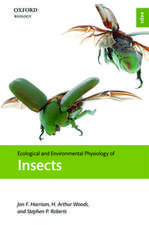Evolutionary Developmental Biology of Invertebrates 3: Ecdysozoa I: Non-Tetraconata
Editat de Andreas Wanningeren Limba Engleză Hardback – 26 aug 2015
This is the first of three volumes dedicated to animals that molt in the course of their lifecycle, the Ecdysozoa. It covers all non-hexapods and non-crustaceans, i.e., the Cycloneuralia, Tardigrada, Onychophora, Chelicerata and Myriapoda. While the Nematoda and all other phyla are treated in their own chapters, the remaining cycloneuralians are presented jointly due to the dearth of available developmental data on its individual subclades.
| Toate formatele și edițiile | Preț | Express |
|---|---|---|
| Paperback (1) | 356.22 lei 38-44 zile | |
| SPRINGER VIENNA – 23 oct 2016 | 356.22 lei 38-44 zile | |
| Hardback (1) | 397.81 lei 3-5 săpt. | |
| SPRINGER VIENNA – 26 aug 2015 | 397.81 lei 3-5 săpt. |
Preț: 397.81 lei
Nou
Puncte Express: 597
Preț estimativ în valută:
76.13€ • 78.65$ • 63.36£
76.13€ • 78.65$ • 63.36£
Carte disponibilă
Livrare economică 04-18 martie
Preluare comenzi: 021 569.72.76
Specificații
ISBN-13: 9783709118641
ISBN-10: 3709118646
Pagini: 220
Ilustrații: VII, 200 p. 72 illus., 58 illus. in color.
Dimensiuni: 178 x 254 x 22 mm
Greutate: 0.65 kg
Ediția:1st ed. 2015
Editura: SPRINGER VIENNA
Colecția Springer
Locul publicării:Vienna, Austria
ISBN-10: 3709118646
Pagini: 220
Ilustrații: VII, 200 p. 72 illus., 58 illus. in color.
Dimensiuni: 178 x 254 x 22 mm
Greutate: 0.65 kg
Ediția:1st ed. 2015
Editura: SPRINGER VIENNA
Colecția Springer
Locul publicării:Vienna, Austria
Public țintă
GraduateCuprins
Cycloneuralia.- Nematoda.- Tardigrada.- Onychophora.- Chelicerata.-Myriapoda.
Recenzii
“This is a volume of a meritorious series that aims to present the current state of knowledge on the development of Ecdysozoa. For this proven experts were won. … shows impressively, what Evolutionary Developmental Biology (Evodevo) may achieve with the techniques available today, giving the researcher, but also the (university) lecturer fresh ideas and suggestions.” (Hartmut Greven, Acta Biologica Benrodis, Issue 18, December, 2016)
Textul de pe ultima copertă
This multi-author, six-volume work summarizes our current knowledge on the developmental biology of all major invertebrate animal phyla. The main aspects of cleavage, embryogenesis, organogenesis and gene expression are discussed in an evolutionary framework. Each chapter presents an in-depth yet concise overview of both classical and recent literature, supplemented by numerous color illustrations and micrographs of a given animal group. The largely taxon-based chapters are supplemented by essays on topical aspects relevant to modern-day EvoDevo research such as regeneration, embryos in the fossil record, homology in the age of genomics and the role of EvoDevo in the context of reconstructing evolutionary and phylogenetic scenarios. A list of open questions at the end of each chapter may serve as a source of inspiration for the next generation of EvoDevo scientists. Evolutionary Developmental Biology of Invertebrates is a must-have for any scientist, teacher or student interested in developmental and evolutionary biology as well as in general invertebrate zoology.
This is the first of three volumes dedicated to animals that molt in the course of their lifecycle, the Ecdysozoa. It covers all non-hexapods and non-crustaceans, i.e., the Cycloneuralia, Tardigrada, Onychophora, Chelicerata and Myriapoda. While the Nematoda and all other phyla are treated in their own chapters, the remaining cycloneuralians are presented jointly due to the dearth of available developmental data on its individual subclades.
This is the first of three volumes dedicated to animals that molt in the course of their lifecycle, the Ecdysozoa. It covers all non-hexapods and non-crustaceans, i.e., the Cycloneuralia, Tardigrada, Onychophora, Chelicerata and Myriapoda. While the Nematoda and all other phyla are treated in their own chapters, the remaining cycloneuralians are presented jointly due to the dearth of available developmental data on its individual subclades.
Caracteristici
First book specifically describing invertebra?te non-model organisms Written by designated experts in the respective areas Richly illustrated and easy-to-understand












